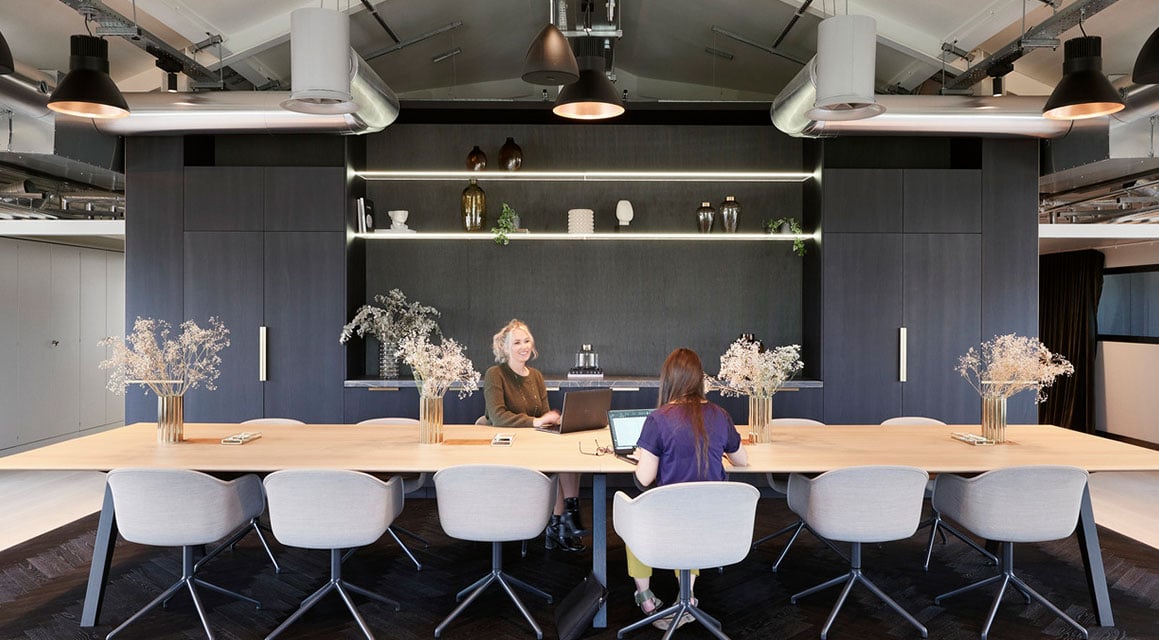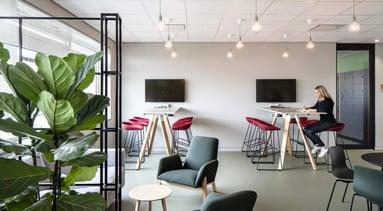Addressing the effect of Covid-19 on mental health by bringing people together

Unispace Global Principal – People & Culture, Nicola Harris, explores the effects of the pandemic on growing mental health and wellbeing issues across the global workforce, and the legacy they may leave. She explains how smart ‘return to the office’ strategies can allay anxieties and provide a genuine boost to employee wellbeing.
As vaccination rollouts get underway, there’s a sense that the end of the pandemic may finally be in sight. However, with lockdowns still ongoing in dozens of countries, experts are predicting “a mental health ticking time bomb” that will outlast the virus itself by some distance.
A vast difference in outcomes
Everyone has experienced the pandemic differently. Some have used the migration to home working as motivation to move out of the city and embrace a different approach or more relaxed pace of life – from Brisbane down to Byron, or from New York City to Westchester, and from London out to the countryside. Others have benefitted from the lack of commute or enjoyed the quiet of their home office. Certainly, for many workers, the pandemic has led to improved work/life balance.
But on the flipside, millions of people have felt comparatively powerless, stuck in their homes, ‘living at work’, juggling home-schooling alongside endless online calls and extended working hours. Many are battling anxiety, depression and other mental health challenges brought on by the isolation, conflicting priorities, trauma and general disruption of the pandemic.
According to Nicola Harris, “Without the usual parameters of routine and office-based work life, many employees have found themselves living a blurry professional/personal existence in which they’re available to colleagues 24/7. They’re spending too much time online and finding it impossible to relax in a home environment that has all of a sudden become mentally associated with workplace angst.”
Just as worrying is the extent to which reportedly domestic violence has increased following lockdowns, not to mention the rise in suicide rates and the challenges in maintaining mental health service provision – an issue that has affected 93% of countries worldwide.
Bringing people together again in the workplace
It’s not easy to assess the wellbeing impact of a year away from the office. At Unispace, we’ve carried out regular employee surveys across EMEA, APAC and The Americas, where our teams are working remotely, to get to the heart of the issues and consider how we can facilitate a ‘return to workplace’ strategy that our entire workforce buys into.
“People need human connections to support their wellbeing, and it’s important to appreciate how employee attitudes have shifted due to the pandemic,” says Nicola. “The physical office can be a great environment for rebuilding connections, and returning has to feel right for every employee, particularly if they’re already be battling poor mental or physical health. At Unispace we’re looking at externally facilitated sessions to help our people prepare psychologically and iron out any concerns they have.”
Our surveys identified recurring themes that can help you shape your own plans for office-based activity in the year ahead:
- Vaccination progress. Most view this as a prerequisite of returning to the office. Consider proactive communications encouraging people to take up the vaccine, as and when they’re eligible and in accordance with professional medical advice.
- Transport. Employees may be reluctant to take rush hour public transport but worried about parking costs/availability. Provide them with guidance on travelling outside of peak commuter times, where to find nearby parking facilities, consider introducing a parking subsidy scheme, and explore any local cycle-hire programmes that could also be promoted.
- In-office behaviours. Employees may be concerned about how their peers will behave. Create clear protocols – for example, around social distancing or mask-wearing – and be proactive in communicating and enforcing these.
- Physical space. Adapting space so it’s safe for employees to return, while still supporting interaction and collaboration will be vital. The office plays an important role in bringing teams together and supporting wellbeing which can be lost when working at home. A Propeller office features space for collaboration, innovation and socialising in a safe way.
Understanding and overcoming resistance
If you’re still encountering a reluctance to return to the office, it may be that employees are not fully aligned with your organisation’s values and culture, and you need to do more to articulate the reasons for returning, compelling benefits of doing so to consider the ‘what’s in it for me’ factor and any positive changes you’re making to the physical environment. If they're struggling with the effects of Covid-19, the positive benefits that the office environment can play with socialisation, collaboration and in-person support should be reinforced.
“Having shown that they can work effectively from home, many employees will be questioning why they’re being asked to rejig their lives once more,” suggests Nicola. “This may mean some necessary soul-searching on the organisation’s part. Why exactly are you asking people to come back, and what steps have you taken to guarantee that it will be worth the change? Your ways of working and personal circumstances may have changed during the pandemic. With many enjoying the benefits of home working, consider where you can adopt the best of home and the office for maximum flexibility with our Propeller framework, and communicate this.”
Support your leadership and management so they're equipped to adapt and engage their teams in new ways of working. At Unispace, we enlisted people managers to meet with their teams to understand personal circumstances and any concerns or anxieties. “We asked managers to make sure physical environments and equipment was adequate, and to get a sense of individual mindsets towards returning to the workplace.”
Key principles for a positive office environment
Early on in the Covid-19 pandemic, we established our Propeller office framework to guide organisations towards the workplace of the future. It's a hybrid office model blending the best of home and office work. At its heart is flexibility – creating versatile spaces that allow all employees to thrive in both environments. As offices start to reopen, flexibility is also key to creating a positive environment for returning teams.
Returning to the office MUST be safe. Health and safety concerns must be acted upon. Creating an environment that has touchless, social distancing measures and sanitisation is core to our Propeller workplace framework. And, if employees cannot get to work safely, they shouldn't be forced in.
- Create the right environment. Our hybrid Propeller model works by making the best of home and office spaces. Ensure your office is set up to maximise functionality to support the way your business will work in the future. We predict the office will be used for more social, innovation and collaborative space, so consider the types of space that will support this in the physical environment.
- Let people come in when they need to. Routine Monday to Friday rush hour commutes are unnecessary. Encourage people to come in for team meetings, planning sessions and workshops and to socialise and collaborate with team members, something that can’t be replicated virtually. Encourage times that are mutually beneficial for them too, so returning to work isn’t a chore. Getting to know your team and their personal circumstances will help with planning.
- Allow for a flexible working day. The office isn't for focus work anymore. Where you can, give people the autonomy to choose how, where and when they work best.
- Understand where everyone is. There’s no need to be prescriptive about where people work, a clear understanding of location and availability is all that’s needed to keep work moving.


